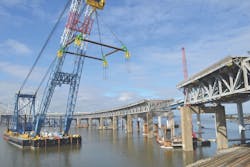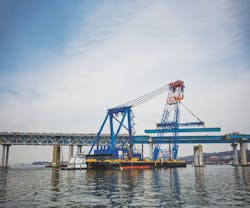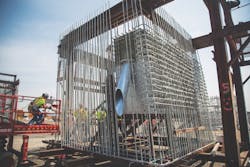Why Hot-Dip Galvanizing is the Backbone of Today's Bridges — and Tomorrow's
By: Powered by the Hot-Dip Galvanized Rebar Alliance
In New York, a bridge carrying 140,000 vehicles/day is replaced.
Until 2017 the Tappan Zee Bridge was a vital crossing of the Hudson River, located just north of New York City and considered integral to the major metropolitan area. At the time it was built in 1955, bridges were estimated to last 50 years. By the 2000s the aging bridge was deteriorating and deemed past its expiration date.
As the owner of the bridge, the New York State Thruway Authority (NYSTA) started constructing a replacement in 2013 with the goal of creating a 100-year, seismically resilient bridge featuring forward-thinking technology and materials that would enable them to maintain the bridge with minimally invasive techniques. The new bridge, named the Gov. Mario M. Cuomo Bridge, utilized hot-dip galvanized (HDG) A767 Class 1 rebar.
Hot-dip galvanized rebar: A major component in the new Gov. Mario M. Cuomo Bridge
Built by consortium Tappan Zee Constructors LLC (a joint venture of several major engineering and construction companies), the new twin-span bridge cost $3.98 billion, stretches 3 miles long and took five years to build. Crossing one of the widest parts of the Hudson River, the Gov. Mario M. Cuomo Bridge is not only the longest bridge in New York state, but it contains one of the longest shared bicycle/pedestrian paths in the nation.
Considered state of the art by many, the bridge attracted considerable national attention during construction. The massive I Lift NY Super Crane, which can lift the equivalent of 12 Statues of Liberty at once, was the star of the show. Meanwhile, the bridge’s backbone, HDG rebar, was hiding under the surface—literally. Approximately every 6 inches of the bridge contains hot-dip galvanized rebar, which NYSTA has used in bridge projects requiring concrete since 1995.
NYSTA realized the benefits of HDG rebar long before construction of the bridge began. In the 1980s, NYSTA was primarily using epoxy-coated rebar for its bridge projects. Despite epoxy-coated rebar’s popularity, it has historically lacked the kind of longevity NYSTA was in need of to maintain its bridge network. The corrosive effects of epoxy coating can be insidious because they are only recognized through severe deterioration—in other words, there is no maintenance strategy against it. When officials see the damage caused by corrosion, it’s already too late for anything but patchwork or repaving/redecking.
“The major cause of deterioration of any reinforced concrete is when water, especially salt-laden water, gets into the concrete and starts to deteriorate the bar and it deteriorates the concrete,” said Paul Provost, now-retired bridge inspector and senior structural engineer for the NYSTA with more than 30 years of experience. “With galvanized rebar, that is not the case.”
NYSTA finds longevity and less maintenance with HDG rebar bridges
“So far [on any bridge utilizing HDG rebar since 1995], NYSTA, generally speaking, hasn’t had to do any maintenance related to those items or the galvanized rebar,” said Provost. “The galvanized coating is mechanical so it bonds to the rebar. It’s more durable. Zinc is a metal that doesn’t expand when it deteriorates. The goal is to eliminate maintenance in the future or reduce it as much as we can and to put work out there that is going to last as long as possible.”
In the 1990s, NYSTA conducted a cost analysis to compare the costs of galvanized rebar with other coating options. According to the American Galvanizers Association, NYSTA initially found that the cost of HDG rebar was slightly more than epoxy and bare steel coatings on a per pound basis. However, more rebar is required for an epoxy-coated rebar installation to accommodate the need for additional lap lengths due to reduced bond strength.
In addition to corrosion protection and cost effectiveness, HDG rebar sustains less damage in the shipping and handling process. With HDG rebar, the product is significantly more difficult to damage. The cathodic action of the zinc protects the bare steel.
Many state transportation agencies contend that HDG rebar is the best value all around. It enables them to achieve lofty bridge lifespans with low maintenance. HDG rebar protects from corrosion, is cost-effective and durable. HDG rebar is proving that maintenance-free bridges are possible. Less maintenance also means less delays to travelers, and improved safety for maintenance workers, contractors and the general public.
About Hot-Dip Galvanizing
HDG reinforced steel is proven to be more robust and durable when it comes to constructing concrete bridge elements. Damage caused by corrosion to rebar will result in repairs and require additional maintenance and traffic control, adding up costs over time. Galvanizing the rebar in a durable zinc coating prevents this corrosion and can help the rebar withstand the rigors of bridge life without compromising the concrete structure.
ASTM A767 applies specifically to hot-dip galvanizing of reinforcing steel. According to the American Galvanizers Association, it is known that the thickness of a galvanized coating greatly impacts the service life of the steel. The thicker it is, the longer it can protect the steel from corrosion. ASTM A767 Class 1 HDG in particular yields a minimum coating thickness of 6 to 8 mils.
HDG rebar has been used on highway bridge projects since the late 1960s. With HDG rebar meeting 100-year lifespan criteria, it results in less maintenance and a much lower cost of ownership—making it an ideal component of major bridge projects nationwide.
Hot-Dip Galvanizing vs. The Rest
Corrosion protection alternatives to HDG fall into one of two categories. In one category the alternatives have similar life expectancy but are more expensive (i.e., stainless steel, stainless steel cladding and MMFX). In the other category, the alternatives have a shorter design life due to a thinner and/or more fragile coating (i.e., continuous galvanized rebar and epoxy). HDG A767 Class 1 is the most efficient and effective option due to its 100-year, maintenance-free design life.
Why More and More Projects are Turning to HDG
Many state DOTs and other organizations mandate it for use or suggest it as an alternative. Several major transportation agencies requiring the use of ASTM 767 Class 1 HDG rebar include the New York State Thruway Authority, Rhode Island DOT, Connecticut DOT and New Jersey Turnpike Authority.
About The Hot-Dip Galvanizing Alliance
The Alliance is a partnership of leading experts and providers of hot-dip galvanizing services and products in the eastern half of the United States and Canada, as well as Bermuda. Created in 2019, the goal of the Alliance is to advocate and educate the merits of life cycle costs and consequently, the use of HDG rebar.
FOR MORE INFORMATION ON THE HOT-DIP GALVANIZED REBAR ALLIANCE, PLEASE CONTACT:
FRANK GERACE, PE
HUBBELL GALVANIZING
315.796.2221
[email protected]
PETER MELEWSKI, PE
PETER MELEWSKI LLC
518.603.2606
[email protected]





